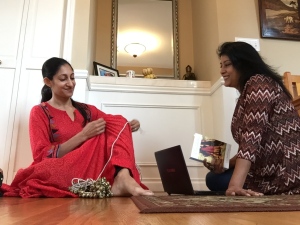This article first appeared in India Currents Magazine.
Lovers of The Twentieth Wife will be excited to know kathak artist Farah Yasmeen Shaikh will soon be interpreting the popular novel on a San Francisco stage. Avid readers will also be thrilled that Indu Sundaresan, acclaimed author of the novel, will narrate the performance. “I watched one of her performances and was absolutely mesmerized by her technique, stamina, and skill” says Indu Sundaresan, author of The Twentieth Wife, of Shaikh’s dynamism on stage. Shaikh and Sundaresan will be joined by a live orchestra to tell the interwoven stories of Emperor Akbar, Prince Salim, and the woman who would become the twentieth wife of Jahangir, Mehrunissa.
“Mughal kings were larger than life. They lived violently and loved violently” explains Sundaresan. The Twentieth Wife, based on a close historical reading of the Mughal Empire in India, focuses on pivotal events in the transfer of power between two of its most influential emperors. The novel’s true genius, though, lies in locating the story’s historical perspective behind zenana walls. Although the novel has already become a TV series, Shaikh and Sundaresan’s performance will offer a new way into a beloved story. “As far as I know the concept had never been done before. Kathak is a dance form that evolved before the time I’m talking about, but it was performed for the Mughals so it seemed like a nice marriage” says Sundaresan.
“I wanted to share the honor I feel representing this part of history, honoring this woman for the poignant place she holds today with gender imbalance in the world,” says Shaikh, artistic director, speaking of Mehrunissa. After falling in love with The Twentieth Wife upon first reading, Shaikh reached out to Sundaresan to propose joining their art forms in an artistic collaboration. “I was deeply moved by reading the book. As a Muslim woman trained in and practicing a classical dance form with Islamic influence, I wanted to bring [these things] together” explains Shaikh.

The result is a dynamic interpretation by Shaikh that inhabits the lives, perspectives, and bodies of Akbar, Salim, and Mehrunissa. “The burden of the entire performance falls on her” says Sundaresan of Shaikh. Sundaresan’s narration will tie the performance to its original form, “The entire dance drama is narrated directly from the novel. I added a little original content to help with the transitions.” The performance will, on a deeper level, also tell the story of the collaboration between these two women. “’It’s not just what you create on the dance floor, you must spend time together, eat together, know each other,’” says Shaikh, quoting her teacher and guru, Pandit Chitresh Das, on the art of collaboration.
Using multi-media effects, a dynamic grouping of musicians, and multiple costume changes, the performance will highlight the unique perspective of imperial women in Mughal history. “In the zenana, in the harem, things happened behind closed doors. The audience may not have been able to see things directly, depending on who they were [historically],” says Shaikh of her shadow-work to portray Mehrunissa’s perspective during the performance. Original music composed by Salar Nader will provide an auditory interpretation for Mehrunissa and other characters, with Ben Kunin on sarod, Raginder Singh Momi on violin, Deepti Warrier on vocals, and Irum Musharraf as vocal support.
“It was kismet,” concludes Shaikh of the opportunity to collaborate with Sundaresan. Female audience members will be inspired by Shaikh’s motivation to “move beyond the repertoire I was taught to find something that uniquely inspires me.” Male audience members will also relate to her interpretation, “So many men find the scene between Akbar and Salim very emotional, and want to talk about it” says Shaikh. Ultimately, the performance will tell the story of the woman who will become Empress Noor Jahan, a woman who becomes much more than simply the power behind the veil. “It is history told in a contemporary context, in a contemporary way” concludes Sundaresan.
This article appeared in the January/February 2015 issue of In Dance.


